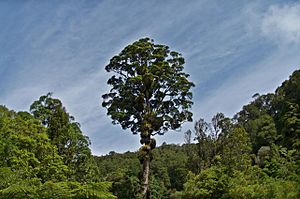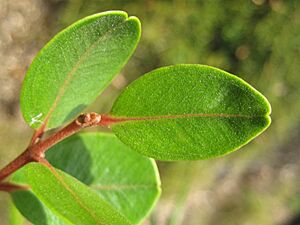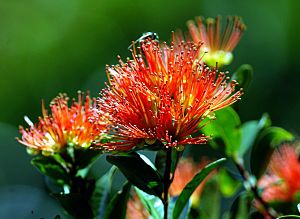Northern rātā facts for kids
Quick facts for kids Northern rātā |
|
|---|---|
 |
|
| A Northern rātā towers above the forest at Kaitoke Regional Park, Wellington | |
| Scientific classification | |
| Genus: |
Metrosideros
|
| Species: |
robusta
|
The northern rātā (its scientific name is Metrosideros robusta) is a special forest tree that only grows in New Zealand. It can grow super tall, sometimes over 25 meters! This tree often starts its life way up high in another big tree. It's like a plant that grows on another plant, called a hemiepiphyte. Over many years, its roots grow down and around the host tree. Eventually, these roots join together to form a huge, often hollow, trunk of their own. But if the ground is open, like after a storm, the northern rātā can start growing right on the ground. Then it will have a normal, but shorter, trunk.
Contents
Where Northern Rātā Trees Grow
Northern rātā trees are found in the North Island of New Zealand. You can see them from Te Paki in the north all the way down to Wellington in the south. They used to be everywhere, but now they are harder to find in many places. For example, they are mostly gone from most of Hawkes Bay.
In the South Island, you can find northern rātā from Nelson to Greymouth and Hokitika. The furthest south they grow is near Lake Mahinapua. These trees naturally live in forests along the coasts and in low-lying areas. Sometimes, they also grow in mountain forests. Long ago, northern rātā and rimu trees were the main trees in a type of forest called rimu/rātā forest.
What Northern Rātā Trees Look Like
The northern rātā is a very big tree. You can tell it apart from other similar trees by its small, tough, dark green leaves. These leaves are about 2.5 to 5 centimeters long and 1.5 to 2.5 centimeters wide. They have a special little notch, or dip, at the very tip.
When new leaves grow, they are often pink and covered in tiny, rust-colored hairs. These hairs usually fall off as the leaves get older. The flowers are bright scarlet red and grow in bunches at the ends of the branches. They are made up of many long, thin parts called stamens. The trees bloom mostly between November and January. It takes about a year for the seeds to become ready.
The bark of the tree is usually brown or gray-brown and feels a bit like cork. This corky bark is a great place for other plants to grow their roots, like Astelia plants and kiekie. The wood of the northern rātā is reddish-brown. Because of how the tree grows, its wood often has a twisted pattern.
How Northern Rātā Trees Grow (Hemi-epiphytic Life Cycle)
Northern rātā trees often start their lives as "hemi-epiphytes." This means they begin growing high up on another tree, usually a rimu tree. As the rātā grows, its roots reach down towards the ground. These roots wrap around the host tree's trunk. Over many years, the rātā's roots get bigger and stronger. They eventually form a huge, hollow trunk around where the host tree used to be.
People used to think the rātā "strangled" its host tree. But now, scientists think that rātā trees might only be able to start growing on trees that are already getting old or sick. Northern rātā trees often live in forests with other trees like rewarewa, tawa, hīnau, kānuka, kahikatea, kāmahi, kohekohe, pukatea, and māhoe.
Protecting Northern Rātā Trees
The biggest danger to northern rātā trees is a type of animal called a possum (Trichosurus vulpecula). Possums eat the leaves, buds, flowers, and young shoots of the tree. If there are too many possums, they can damage a tree so badly that it dies in just a couple of years. In some areas, this has caused the northern rātā to disappear completely.
Luckily, groups like Project Crimson are working hard to protect these trees. They help control possums and plant new rātā trees. Another problem for northern rātā is mixing with pōhutukawa trees. Pōhutukawa trees are now growing in areas where they didn't naturally grow before. When they grow near northern rātā, they can sometimes create hybrid trees, which can affect the pure northern rātā species. Other threats include cutting the trees for firewood or clearing forests for roads and buildings.
Growing Northern Rātā Trees
You can easily grow northern rātā trees from fresh seeds. But you need to plant the seeds quickly because they don't stay good for very long, especially if they dry out. It's harder to grow them from cuttings (pieces of the plant), but you might have better luck using young shoots that grow straight up.
There are also some special types of northern rātā that people have grown, called cultivars. These include 'Kawa Copper', 'Krinkley', and 'Rangitoto Island'. There are also hybrid cultivars, which are mixes of northern rātā with pōhutukawa or southern rātā.
Images for kids
See also
 In Spanish: Árbol rata del norte para niños
In Spanish: Árbol rata del norte para niños






